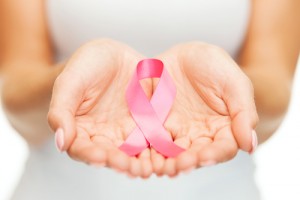 Breast cancer refers to the formation of malignant tumors in the breast tissue. Among the symptoms are a lump in the breast, a change in the breast’s shape and size, drainage from the nipples, dimpling of the skin, and red patches on the skin of the breast.
Breast cancer refers to the formation of malignant tumors in the breast tissue. Among the symptoms are a lump in the breast, a change in the breast’s shape and size, drainage from the nipples, dimpling of the skin, and red patches on the skin of the breast.
Eventually, these abnormal cells may start invading nearby organs — called metastasizing. The most common targets are beneath the arms, collar bones, in the chest behind the breast bones, and in the lymph nodes.
A non-invasive form of early breast cancer is ductal carcinoma in situ (DCIS), which means the cancer is in the cells that line the ducts, but has not spread through the walls of the ducts to the breast tissue. Around 20 percent of the new cases that are diagnosed are DCIS, and nearly all women at this stage, if found early enough, can be cured, according to the American Cancer Society (ACS).
Invasive ductal carinoma (IDC), considered the most common type of breast cancer (approximately eight of 10 invasive breast cancers are IDCs), starts in a milk duct but then breaches the duct to invade the breast tissue. The ACS notes that at this stage, it can metastasize to other organs in the body via blood vessels or the lymphatic system.
Lobular carcinomas: A woman can be diagnosed with non-invasive lobular carcinoma in situ (LCIS), where the abnormal cells form in the lobules, or milk-producing glands, of the breast and have not spread; or, invasive lobular carcinoma (ILC), where the cancer cells have broken through the lobules to the fatty breast tissue. This type can spread to other areas of the body. Of the invasive breast cancers, about 1 in 10 are ILC.
A rare but aggressive condition is inflammatory breast cancer (IBC), where local lymphatic ducts are invaded by cancer cells, blocking fluid drainage and causing breasts that are swollen and and where the skin appears pitted, sort of like an orange peel. Oncologists now know the breast is not inflamed, although it may appear so. IBC accounts for about 1 to 3 percent of all breast cancers in the U.S. Because there is no lump and it may not appear on a mammogram, IBC is not diagnosed as often as some other breast cancers, and its chances of spreading are greater.
Rare types of breast cancer include Paget disease of the nipple. This cancer starts in the milk ducts, spreads to the skin of the nipple and to the areola.
Phyllodes tumor starts in the connective tissue of the breast (compared to carcinomas, which start in the breast ducts or lobules), and are generally benign, but not always.
There are types and subtypes of invasive breast carcinomas, and your physician can explain them in detail.
Clinicians note that not every lump found in the breast is a cancer. It might be a condition called duct ectasia or an ulcer. Still, if a man or woman feels a lump, it should be checked out right away. Early detection is imperative to treating and surviving breast cancer.
Both men and women can develop breast cancer, but it is vastly more common in women. The ACS estimates that only 1 percent of all breast cancers will develop in men, and a man’s lifetime risk of getting the disease is about 1 in 1,000.
Compare this to women: about one in eight women in the U.S. are estimated to get breast cancer at some point in their life. Breast cancer is the No. 1 cause of death in Hispanic women, and the No. 2 cause of death in U.S. women, according to mortality statistics. And 1 in 36 women is expected to die of breast cancer.
The ACS estimated that in 2015, about 292,000 women would be diagnosed with breast cancer, and about 40,000 would die from the disease.
Scientists have yet to find a cure for this deadly disease. There has been a gradual increase in lifespan and survival rates, especially in developed countries. Regular screening of women between the ages of 40 and 75 is considered necessary for women’s wellness, at least once every two years (annually is best).
[adrotate group=”3″]
To confirm a diagnosis of breast cancer, physicians require a biopsy of the breast tissue along with other lab tests. Radiation and chemotherapy, with or without targeted hormone therapy, are the most common means of treating breast cancer, depending on the stage and size of the tumor. Preventive measures include a complete surgical removal — known as a single or double mastectomy (partial or total removal of one or both breasts) — depending on genetic screening and the age of the patient. In some less-aggressive cases, physicians may approve breast conserving surgery (a kind of lumpectomy, which involves removing the lump from the breast, rather than the entire breast).
 Epidemiology:
Epidemiology:
Breast cancer is the most common form of invasive cancer in women. It is the second leading cause of death in women, only behind lung cancer. In the U.S., the rate of incidence per 100,000 women for breast cancer is the highest (90), followed by Western Europe (78) and Northern Europe (73). Southern and Eastern Europe (56 and 49 respectively) and South America (42) have lower rates of incidence, and the lowest is seen in Asian countries (around 26 to 30). However, in countries like Japan, Singapore, and China, there has been an increase in the number of cases reported over the past few decades, perhaps because of a shift to a more Western lifestyle.
Etiology:
Genetic cellular abnormalities are attributed to the development of cancers, and breast cancer is no exception. Exposure to environmental pollutants, smoking, alcohol consumption, obesity, lack of exercise, high cholesterol, and other unhealthy lifestyle options have also been suggested as triggers to genetic mutations which give rise to cancerous growth of cells.
The main genes studied in hereditary breast cancer are two of the tumor suppressor genes, BRCA1 and 2 (standing for Breast Cancer early Onset 1 and 2), located on the longer arms of chromosomes 17 and 13, respectively. They are responsible for the repair of damaged and broken DNA and destruction of faulty DNA which cannot be repaired.
Some other genes which have been studied in this regard include CHEK2, ATM, BRIP1, and PALB2, p53, STK11 and PTEN, the latter three being responsible for an array of genetic conditions like Li-Fraumeni, Peutz-Jeghers syndrome, and Cowden’s syndrome respectively, which greatly increase the risk of developing breast cancer. Researchers concluded that women who develop breast cancer along with another form of epithelial cancer, and those who develop the disease at an earlier age, likely have a genetic predisposition for the disease, rather than falling prey to other risk factors.
Having a family member or a first-degree relative with breast cancer nearly doubles a woman’s chances of developing the condition. And, if that relative developed the disease at an age younger than 50, then the risk multiplies itself. The risk is increased four to six times if there is more than one first degree relative with the disease, along with similar age-dependent conditions.
Several risk factors also increase susceptibility towards developing breast cancer. They include:
- Increasing age: It is probably the biggest risk factor for breast cancer. With every 10 years after menopause, the risk multiplies itself twofold. The disease is rare in women younger than 25, but most common in women between 50 and 75.
- Geographical variation: The risk of developing breast cancer increases five times from a geographic move from a country where the disease has less of an incidence to one where the incidence and mortality rates are considerably greater. This is generally reflected in migrants within one or two generations, and in moves from developing countries to developed, urbanized countries. This indicates that environmental factors may play an important part in development of the disease.
- Age at menstruation and menopause: Women who start menstruation early, before the age of 12, or reach menopause late, after 55, are at twice the risk of developing breast cancer than other women. However, women who have their ovaries removed by the age of 35 are at a reduced risk of breast cancer.
- Late pregnancy: Having a first child later than 35 years also poses a higher risk of breast cancer among women. Having no children at all, and the absence of breastfeeding among women also pose equal risks of breast cancer at later stages in liffe. A second pregnancy soon after the first one reduces the risk.
- Neoplastic and benign conditions affecting the breast, like ductal and lobular carcinoma in situ (DCIS, LCIS), previous history of breast or ovarian cancer, hyperplasia, papillomatosis, and microglandular adenosis, all contribute to increased risks of getting breast cancer in the future.
- Previous medical conditions like Hodgkin’s lymphoma, or other epithelial cancers, which require radiation therapy, increase a person’s chances of developing breast cancer.
- Exogenous hormones, mostly in the form of oral contraceptives and hormone replacement therapy, have been a topic of research over their contribution to developing breast cancer. Some people using oral contraceptives with a mixture of estrogen and progesterone for 10 years or more have a 1.24 times increased risk of breast cancer. However, this risk decreases over a decade once they stop taking the pills. The same goes for hormone replacement therapy in menopausal women who take a mixture of estrogen and progesterone for more than five years; the risk appears to normalize within five years of stopping the therapy.
- Lifestyle changes like being smoking, increased alcohol consumption, exposure to environmental pollutants and carcinogens, and use of certain drugs like diethylsilbesterol (DES, a drug prescribed to prevent miscarriage) pose a threat for developing breast cancer as well.
Read about Breast Cancer Signs & Symptoms
Note: Breast Cancer News is strictly a news and information website about the disease. It does not provide medical advice, diagnosis, or treatment. This content is not intended to be a substitute for professional medical advice, diagnosis, or treatment. Always seek the advice of your physician or other qualified health provider with any questions you may have regarding a medical condition. Never disregard professional medical advice or delay in seeking it because of something you have read on this website.
